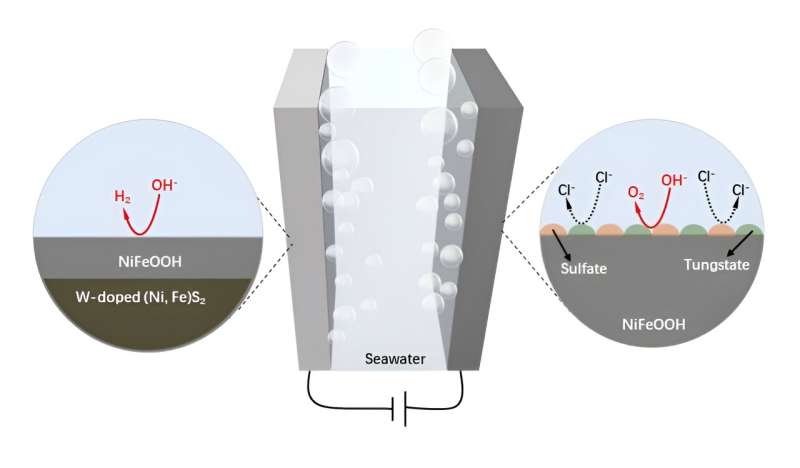
August 13, 2024 by Science China Press
Collected at: https://techxplore.com/news/2024-08-sustainable-hydrogen-production-seawater-electrolysis.html
Seawater electrolysis holds immense promise as a means to decarbonize the global energy sector. However, challenges such as anode corrosion by chloride ions, unwanted chloride oxidation reactions, and the high cost of catalysts have hindered direct seawater electrolysis.
To address these issues, self-supported nickel-iron (NiFe) materials have emerged as attractive bifunctional catalysts for both hydrogen evolution and oxygen evolution due to their high intrinsic activity and affordability. Wood-based carbon (WC) structures have gained attention as an ideal substrate for these active materials due to their hierarchical porous nature and excellent conductivity.
In a bid to enhance the stability of NiFe-based electrodes in seawater electrolysis, a new approach was devised by Prof. Hong Chen (Southern University of Science and Technology in China), Prof. Bing-Jie Ni (University of New South Wales in Australia), and Prof. Zongping Shao (Curtin University in Australia). The research is published in the journal Science Bulletin.
Through the introduction of tungsten into the active NiFe-based catalysts, the anti-corrosion properties and stability of the anodes were significantly improved. The innovative WC-supported W-doped NiFe sulfide (W-NiFeS/WC) electrode was developed for efficient overall seawater electrolysis through a specialized preparation method involving impregnation and sulfidation.
The team found that the W-NiFeS/WC electrode showcased a three-dimensional hierarchical porous structure with oriented microchannels, densely anchored W-NiFeS nanoparticles, and high porosity, bolstering its electrical conductivity and efficiency. The electrode’s performance was further enhanced by its rich redox-active centers, excellent electrocatalytic properties, and stability in alkaline seawater conditions.
The innovative electrode demonstrated superior activity and stability in both the oxygen evolution reaction (OER) and hydrogen evolution reaction (HER) in alkaline seawater, outperforming traditional catalysts.
“The in situ structure evolution of W-NiFeS/WC in OER generates anti-corrosive tungstate and sulfate species on the surface of active Ni/Fe oxyhydroxides. Also, the self-evolved W-NiFeS decorated NiFeOOH can catalyze HER efficiently,” says Zhijie Chen, the first author. Its low fabrication cost and high effectiveness make it a compelling choice for seawater electrolysis, contributing significantly to the advancement of sustainable hydrogen fuel production.
This research not only underscores the importance of structure reconstruction for energy conversion reactions, but also showcases the potential of wood waste-derived carbon structures in advanced electrochemical device design. In addition, by repurposing abundant wood waste into efficient catalysts for seawater electrolysis, this work embodies a circular economy approach, minimizing waste generation, and promoting sustainable green hydrogen production from seawater.
More information: Zhijie Chen et al, Reconstructed anti-corrosive and active surface on hierarchically porous carbonized wood for efficient overall seawater electrolysis, Science Bulletin (2024). DOI: 10.1016/j.scib.2024.05.044

Leave a Reply